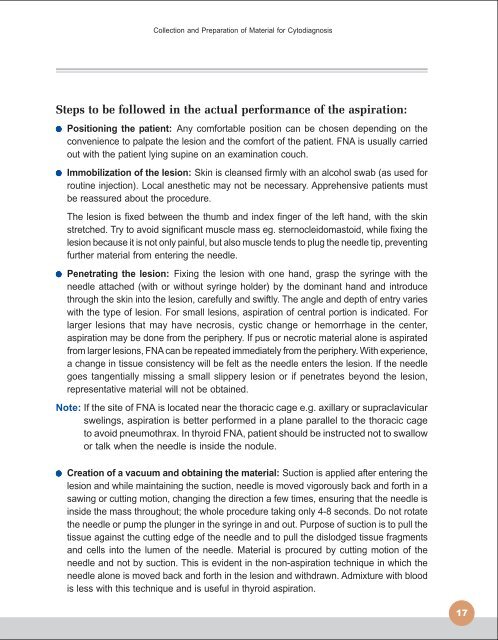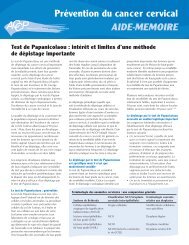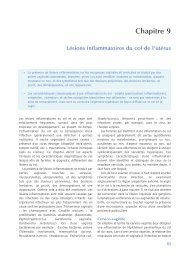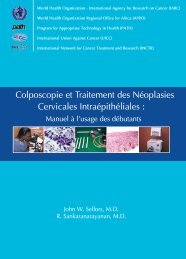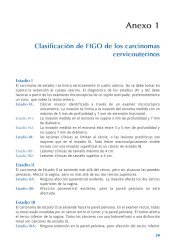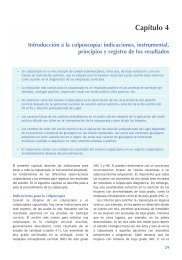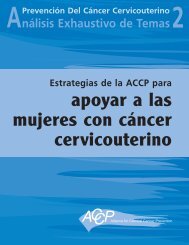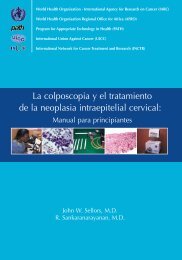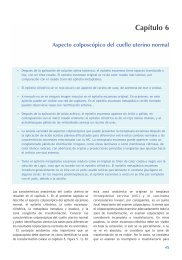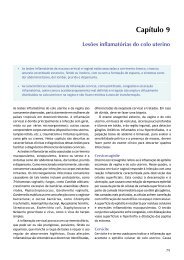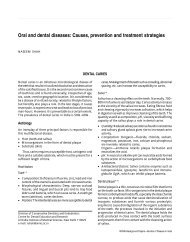Manual for Cytology - IARC Screening Group
Manual for Cytology - IARC Screening Group
Manual for Cytology - IARC Screening Group
You also want an ePaper? Increase the reach of your titles
YUMPU automatically turns print PDFs into web optimized ePapers that Google loves.
Collection and Preparation of Material <strong>for</strong> Cytodiagnosis<br />
Steps to be followed in the actual per<strong>for</strong>mance of the aspiration:<br />
● Positioning the patient: Any com<strong>for</strong>table position can be chosen depending on the<br />
convenience to palpate the lesion and the com<strong>for</strong>t of the patient. FNA is usually carried<br />
out with the patient lying supine on an examination couch.<br />
● Immobilization of the lesion: Skin is cleansed firmly with an alcohol swab (as used <strong>for</strong><br />
routine injection). Local anesthetic may not be necessary. Apprehensive patients must<br />
be reassured about the procedure.<br />
The lesion is fixed between the thumb and index finger of the left hand, with the skin<br />
stretched. Try to avoid significant muscle mass eg. sternocleidomastoid, while fixing the<br />
lesion because it is not only painful, but also muscle tends to plug the needle tip, preventing<br />
further material from entering the needle.<br />
● Penetrating the lesion: Fixing the lesion with one hand, grasp the syringe with the<br />
needle attached (with or without syringe holder) by the dominant hand and introduce<br />
through the skin into the lesion, carefully and swiftly. The angle and depth of entry varies<br />
with the type of lesion. For small lesions, aspiration of central portion is indicated. For<br />
larger lesions that may have necrosis, cystic change or hemorrhage in the center,<br />
aspiration may be done from the periphery. If pus or necrotic material alone is aspirated<br />
from larger lesions, FNA can be repeated immediately from the periphery. With experience,<br />
a change in tissue consistency will be felt as the needle enters the lesion. If the needle<br />
goes tangentially missing a small slippery lesion or if penetrates beyond the lesion,<br />
representative material will not be obtained.<br />
Note: If the site of FNA is located near the thoracic cage e.g. axillary or supraclavicular<br />
swelings, aspiration is better per<strong>for</strong>med in a plane parallel to the thoracic cage<br />
to avoid pneumothrax. In thyroid FNA, patient should be instructed not to swallow<br />
or talk when the needle is inside the nodule.<br />
● Creation of a vacuum and obtaining the material: Suction is applied after entering the<br />
lesion and while maintaining the suction, needle is moved vigorously back and <strong>for</strong>th in a<br />
sawing or cutting motion, changing the direction a few times, ensuring that the needle is<br />
inside the mass throughout; the whole procedure taking only 4-8 seconds. Do not rotate<br />
the needle or pump the plunger in the syringe in and out. Purpose of suction is to pull the<br />
tissue against the cutting edge of the needle and to pull the dislodged tissue fragments<br />
and cells into the lumen of the needle. Material is procured by cutting motion of the<br />
needle and not by suction. This is evident in the non-aspiration technique in which the<br />
needle alone is moved back and <strong>for</strong>th in the lesion and withdrawn. Admixture with blood<br />
is less with this technique and is useful in thyroid aspiration.<br />
17


